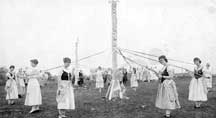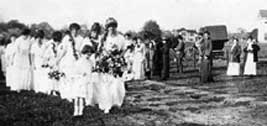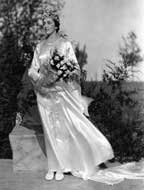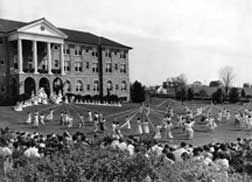Traditions are a cherished part of college life but, more often than not, they are fleeting things. Usually, a tradition flourishes for a few years and then disappears, remaining alive only in the fading pages of yearbooks and in memories of alumni.

But every once in while, a college or university tradition becomes ingrained in the institution's fabric and has a life span measured in decades, not years – transcending classes and generations.
Such a tradition existed at James Madison University in the form of an annual spring ritual, the May Day celebration. Although the celebration has now vanished into history, May Day was a treasured part of the institution's life for some six decades, spanning the days from the State Normal and Industrial School for Women to the State Teachers College at Harrisonburg to Madison College.
May Day celebrations at Madison were far from unique. At dozens of colleges in the early 20th Century, May Day was an important spring custom.
The origin of May Day as a celebration dates back more than 2,000 years. Like many ancient festivals, May Day has a Pagan connection. It was an important holiday for the Druids and was widely observed throughout Great Britain and much of Europe from the Middle Ages until well into the 20th Century.

The Harrisonburg Normal's first May Day celebration was in 1913, when Elizabeth Kelley, president of the Senior Class, was crowned as the school's first May Queen. On this occasion, students carrying garlands of green leaves marched from Dormitory No. 1 (now Jackson Hall) to the Maypole, which was located near Science Hall (now Maury Hall).
Students formed a circle around the pole while the seniors performed a Maypole dance, intertwining ribbons in their class colors of green and white. May Day songs and the class song were performed, the queen was crowned, and the students marched to the gymnasium for games until time to march to the dining hall for dinner.

Harriet Pearson of Winchester.
During some years in the early history of the institution, the May Day celebration was held in conjunction with a Shakespearean festival.
For a number of years, the president of the senior class was crowned May Queen. The exercises were held on Maypole Hill, about where the upper end of Alumnae Hall is today. The May Queen and her court were later chosen in a spirited competition decided by a vote of the student body.
In 1935, a May Day dance became part of the annual activities. During most of the 1940s, two May Day dances were held – one orchestra played in Reed Hall (now Keezell Hall) for upperclass students and another played in Ashby Hall for freshmen.
In many years, several Maypole dances were performed simultaneously before a large crowd, which included many townspeople as well as members of the college community.
May Day reached its pinnacle at Madison College in the 1950s and early 1960s. A typical May Day celebration then was an all-day event, opening with caroling before breakfast and often including music between classes during the morning.
Dormitories and sorority houses were decorated in competition for cash prizes. For three years in the mid-50s, a parade downtown with student floats preceded the May Day ceremony.

Beginning in 1953, the annual Alumni Homecoming was held on May Day instead of in March. For the college's 50th anniversary celebration, a two-day Arts Festival was part of the 1958 May Day weekend.
The world changed dramatically in the 1960s and Madison College changed with it. At Madison and many other schools throughout the country, the changing social climate among college students meant the sure death of May Day celebrations.
In the turbulent late 1960s and early 1970s, a Maypole and a May Queen had little appeal or relevance for students who were protesting the Vietnamese War and rebelling against stringent and antiquated campus social regulations.
May Day ended not with a bang, but with a whimper. Interest in the program had gradually eroded during the 1960s and Dr. Fay Reubush, then dean of women, made the recommendation to discontinue May Day after the 1971 observance. It wasn't a tough call: “The students said they simply weren't going to do it any more,” she said. (Reubush was an administrator at JMU from 1966 to 1989. When she retired, she was an associate vice president for academic affairs.)
“May Day died a natural death,” Reubush said.
--Fred Hilton
